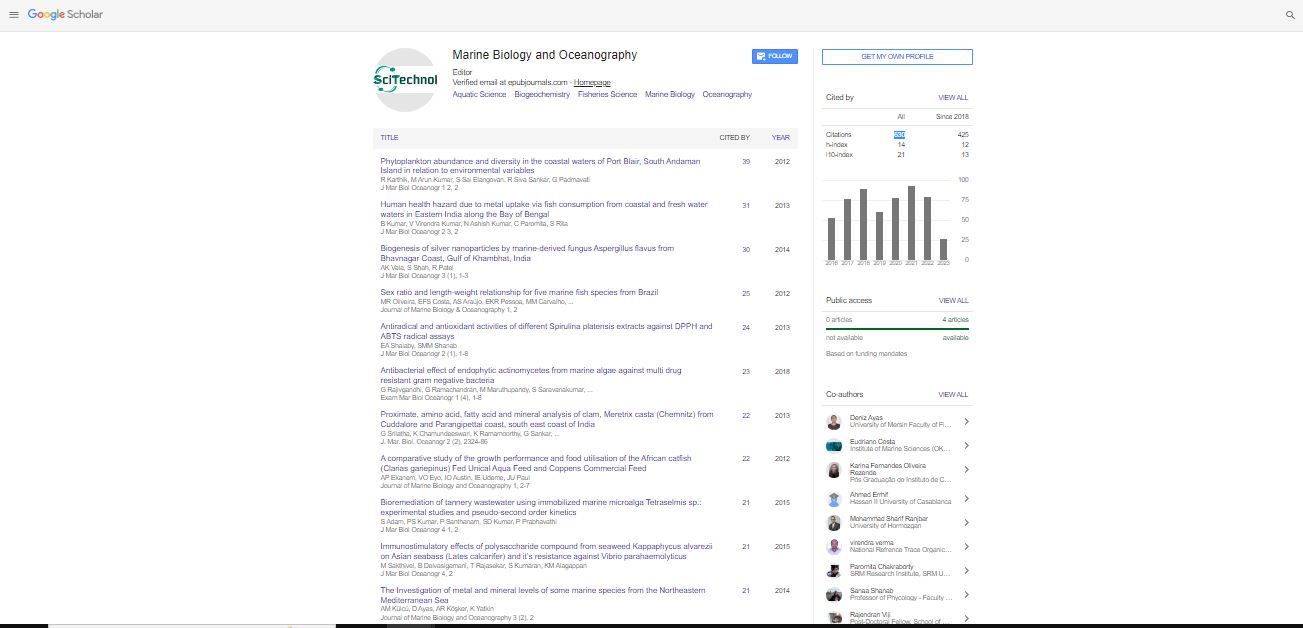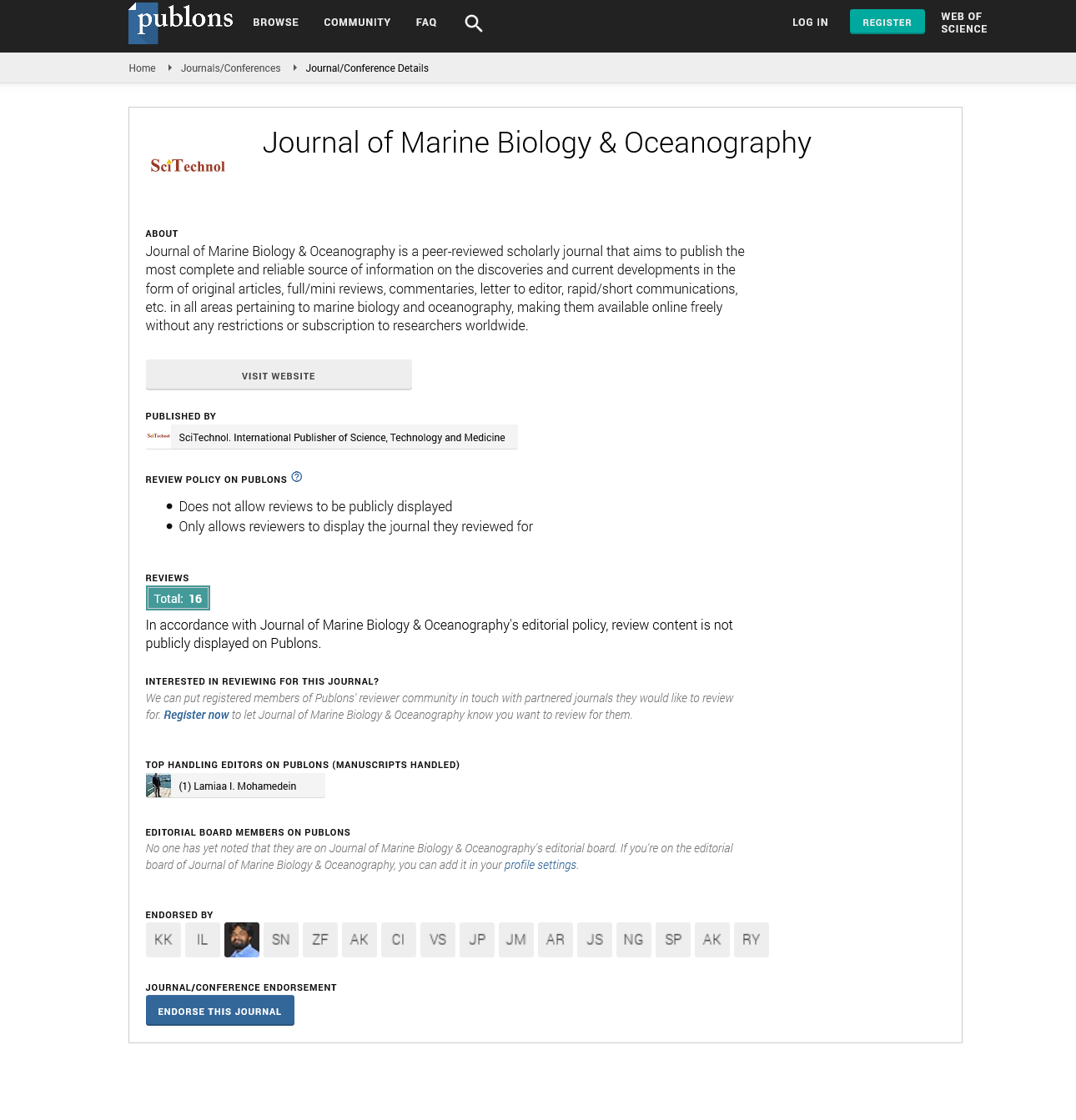Perspective, J Mar Biol Oceanogr Vol: 11 Issue: 5
Marine Chemistry in the Cryogenian Nanhua Basin
Anita Bandrowski*
Department of Neuroscience, Sci Crunch University, CA, USA
*Corresponding author: Anita Bandrowski
Department of Neuroscience, Sci Crunch University, CA, USA
Email: anitab89@gmail.com
Received date: 13 April, 2022; Manuscript No. JMBO-22-52521;
Editor assigned date: 15 April, 2022; PreQC No. JMBO-22-52521 (PQ);
Reviewed date: 26 April, 2022; QC No. JMBO-22-52521;
Revised date: 06 May, 2022; Manuscript No. JMBO-22-52521 (R);
Published date: 16 May, 2022; DOI: 10.4172/2324-8661.1000241
Citation: Bandrowski A (2022) Marine Chemistry in the Cryogenian Nanhua Basin. J Mar Biol Oceanogr 11:5.
Keywords: Marine Chemistry
Description
Relating and probing enterprises about individual healthcare professionals practice is an important way that nonsupervisory bodies cover the public. One way that regulators come apprehensive of these enterprises is through reports made by other healthcare professionals. While all nurses are under an ethical duty to cover cases from detriment and report unsafe practice, in numerous Canadian authorities, certain reports to nonsupervisory bodies are fairly commanded. There's considerable variation in the legislative obligatory reporting fabrics across these Canadian authorities, primarily in the compass of reportable conduct and the threshold that triggers the demand to report. Eight businesses have statutory conditions for RNs to report certain enterprises about fellow healthcare professionals to controllers. The most common reportable conduct in legislative obligatory reporting vittles in Canada is sexual misconduct or sexual abuse of a case. In six businesses, obligatory reporting conditions extend beyond sexual abuse or misconduct to enterprises about conduct, capability and capacity. There was variability in the language used in these legislative vittles across all reviewed authorities. Understanding the legal reporting conditions across authorities is important for nurses, particularly those engaging in virtual practice or else rehearsing across parochial/territorial boundaries. We identify rudiments that would profit from further thickness across authorities and consider the future of fairly commanded reporting for RNs. As the legislative fabrics in colorful authorities are witnessing reform, controllers and policymakers should critically estimate obligatory reporting fabrics to allow for lesser adjustment and further effective reporting in the public interest.
Throughout the COVID-19 epidemic, numerous US epidemiologists and policymakers turned to an index called test positivity or the percent of tests coming back positive for SARSCoV-2, to contextualize COVID-19 case counts with testing volume. But the nation's patch worked health data structure composed of 56 systems managed by each state and home, complicated sweats to calculate the metric in a similar way across US authorities. We set out to collude jurisdictional reporting differences in test positivity and probe whether they obtruded with its effectiveness and community as an index. Understanding these differences is important because jurisdictional test positivity informed consequential policy and individualities’ understanding of threat in their communities. We surveyed the health department websites of all US countries and homes to examine how these authorities were presenting test positivity on COVID-19 dashboards. When details about delineations were unapproachable on jurisdictional websites, we reached out to jurisdictional public health officers for explanation. We also scored authorities donations against stylish practices we linked for calculating the metric. Among the 48 countries and homes posting test positivity values, we observed no agreement on how to calculate the metric authorities used different units, test types, comprising ways, and dating schemes. By looking at data for authorities that posted multiple test positivity criteria, we observed that these definitional differences could affect in variations from 31 to 300. Only four countries were following all ten of the stylish practices for reporting test positivity. The sheer number of ways countries and homes define test positivity is intimidating, given how important the index told US COVID-19 policy. Grounded on our check, we believe the confidence of controllers in the perfection and public community of test positivity is lost the standard's value reflects state and territorial reporting opinions as much as factual viral frequency. These findings emphasize the need to invest in centralized public health structure and produce public reporting norms to ameliorate concinnity of state reporting.
Jurisdictional Websites
The United Nations General Assembly Resolution 69/292 formally established the accommodations on a new fairly binding instrument for the conservation and sustainable use of marine Biodiversity Beyond Public Governance (BBPG). This resolution stated that the instrument “should not undermine” being bodies and legal instruments. While an agreement on the accurate legal interpretation of this demand has largely escaped the delegations, it's rather how this directive is utilized by countries within the accommodations that are most meaning. Specifically, this composition will explore Australia’s use of the “not undermining” directive at the BBNJ accommodations in order to further clarify its implicit function. Of particular interest is how countries may shape the direction of the accommodations to serve their policy interests through counting on the authority of this original directive. Australia’s interests in Regional Fisheries Management Organizations (RFMOs) will serve as a case study when examining how this miracle plays out in practice. Eventually, conditional answers to burning questions regarding “not undermining” will be determined grounded on Australian positions. These answers will be varied with the current BBNJ draft textbook in order to punctuate how state interests at the accommodations will affect the meaning specified to the “not undermining” directive going forward. The transnational legal agreement on the conservation and sustainable use of marine natural diversity of areas beyond public governance (the BBNJ Agreement) presently being developed by the United Nations will be the foundation for conservation and sustainable use of these marine areas for the foreseeable future. As presently formulated the draft textbook seems more acquainted to a reactive approach, grounded on the use of Environmental Impact Assessment (EIA) to respond to proffers rather than proactively pursuing what needs to be done to insure sustainability of ocean ecosystems in ABNJ. In this paper we argue that a strategic environmental assessment process could transfigure the way that the BBNJ agreement approaches conservation and sustainable use. By conceptualizing Ocean as a process designed to grease strategic allowing it can grease a visionary approach to ecosystem function conservation and enable transitions toward sustainability. Inshore spots displayed fishing pressure time round whereas coastal spots only had fishing season open during a many months of summer. Collected individualities were measured for weight and length, also progressed, sexed, and reproductive phase linked using the following criteria resting, spawning able, laboriously spawning, and regressing. Individualities in all reproductive phases were collected at three of the four spots. Spawning season was observed from April to September, with June linked as the induction of the peak spawning period. Doused oocytes were observed, which indicated imminent begetting within 12 h. Although 79 of womanish L. Campechanus at all spots combined were mature grounded on reproductive phase, utmost fish were small, youthful, and inshore spots only made up 12 of the mature ladies. Several individualities were mature at coastal spots compared to only a many at inshore spots, yet fishing pressure was advanced at inshore spots. We suggest that L. Campechanus were spawning able and laboriously spawning when those individualities were several times of age, but youngish, slightly mature individualities comprised the maturity. Therefore, L. Campechanus include ARs in their life cycle and directly generate on state and civil ARs when given enough time to achieve reproductive maturity. Still, fisheries operation should consider administering advanced restrictions depending on the governance to allow individualities to develop and generate before prisoner in both state and civil authorities. Capacity structure and the transfer of marine technology (CB&TT) is crucial corridor of accommodations at Intergovernmental Conferences on a transnational fairly binding instrument regarding the conservation and sustainable use of marine natural diversity of areas beyond public governance (BBNJ). Throughout the accommodations, divergent views persisted among governments. One possible reason for such a situation is the lack of comprehensive understanding of being CB&TT sweats. In this case study, we assessed how these being sweats could contribute to capacity structure for the effective perpetration of a recently proposed BBNJ agreement. A review of CB&TT systems enforced by Japanese associations showed that there was a significant quantum of sweats applicable to BBNJ We also plant that numerous of them handed platforms that could be applied to CB&TT for BBNJ. Still, systems specifically acclimatized for BBNJ were still limited. Likewise, there were several assignments from being sweats that could give useful perceptivity for unborn enterprise.
 Spanish
Spanish  Chinese
Chinese  Russian
Russian  German
German  French
French  Japanese
Japanese  Portuguese
Portuguese  Hindi
Hindi 
